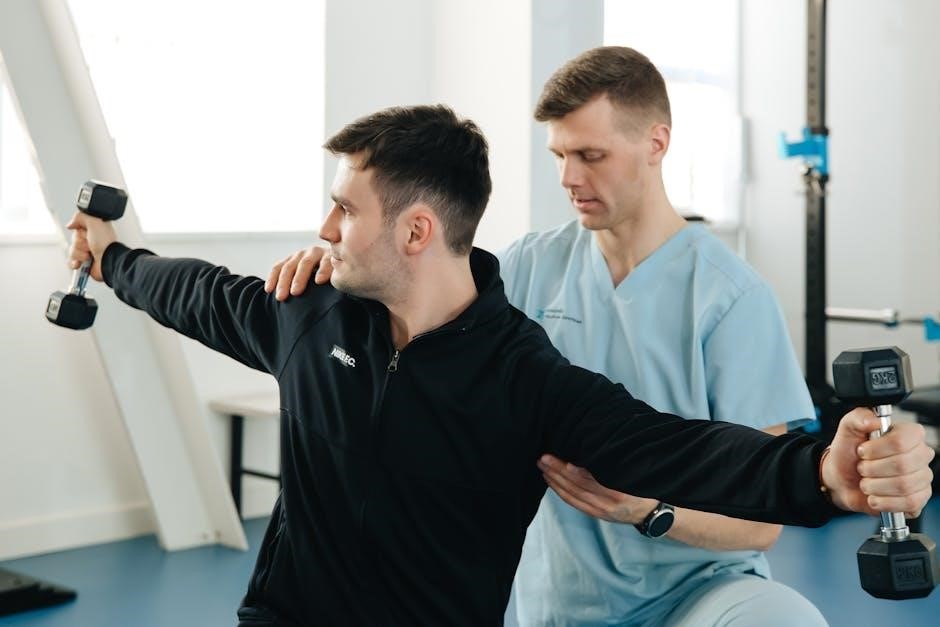trainer manual
A trainer manual is a comprehensive guide designed to help trainers deliver effective training sessions. It outlines objectives‚ content‚ and methods to ensure consistent and impactful learning experiences.
What is a Trainer Manual?
A trainer manual is a structured guide containing detailed instructions‚ materials‚ and resources for delivering training programs effectively. It typically includes training objectives‚ content outlines‚ and delivery methods. This document ensures consistency and quality in training‚ providing trainers with a clear roadmap. It often incorporates activities‚ assessments‚ and visual aids to engage participants. The manual also serves as a reference for trainers‚ helping them adapt content to different audiences while maintaining core learning objectives. By organizing information logically‚ it simplifies the training process and ensures alignment with organizational goals. Ultimately‚ a well-crafted trainer manual enhances the learning experience‚ making it easier for trainees to absorb and apply new knowledge and skills.
- Clarifies training objectives and outcomes.
- Provides structured content and activities.
- Ensures consistency across training sessions.
- Supports trainers in adapting to diverse audiences.
Importance of a Trainer Manual
A trainer manual plays a crucial role in ensuring effective training delivery and learner engagement. It provides a clear framework‚ allowing trainers to maintain consistency and focus on key objectives. By organizing content systematically‚ it helps trainers cover all essential topics thoroughly. Additionally‚ the manual serves as a valuable resource for trainees‚ offering them a reference point for reviewing material. It also enhances the overall learning experience by incorporating interactive elements and visual aids‚ which cater to different learning styles. Moreover‚ a well-structured manual facilitates better retention of information‚ enabling trainees to apply their knowledge more effectively in real-world scenarios. Ultimately‚ the importance of a trainer manual lies in its ability to streamline the training process‚ making it more efficient and impactful for both trainers and trainees alike.
- Ensures consistency in training delivery.
- Enhances learner engagement and retention.
- Provides a structured framework for trainers.
- Supports diverse learning styles through varied content.

Preparation for Training Delivery
Effective preparation ensures a smooth and impactful training session‚ fostering an environment conducive to learning and engagement‚ while enabling trainers to deliver content confidently and efficiently.
- Plan thoroughly to cover all essential topics.
- Set up the environment to promote focus.
- Prepare resources to support trainee understanding.
Understanding the Target Audience
Understanding the target audience is crucial for delivering effective training. It involves analyzing demographics‚ job roles‚ and prior knowledge to tailor content appropriately. Assessing skill levels and learning gaps ensures relevance. Recognizing diverse learning styles and preferences helps create an inclusive environment. Additionally‚ identifying trainees’ motivations and expectations allows alignment with their goals. This insights-driven approach enhances engagement and ensures the training meets specific needs‚ fostering better outcomes. By prioritizing audience understanding‚ trainers can design sessions that resonate deeply and achieve intended objectives.
- Analyze demographics and job roles for content relevance.
- Assess existing knowledge to address gaps effectively.
- Consider diverse learning styles for inclusive delivery.
- Align training with trainees’ motivations and expectations.
Defining Training Objectives

Defining clear training objectives is essential for ensuring the training program achieves its intended outcomes. Objectives should be specific‚ measurable‚ achievable‚ relevant‚ and time-bound (SMART) to guide the content and delivery. They provide a roadmap for both trainers and trainees‚ ensuring alignment with organizational goals. Well-defined objectives help focus the training material‚ assess progress‚ and evaluate success. Trainers should collaborate with stakeholders to identify key outcomes and communicate them clearly to trainees. This clarity ensures everyone understands what is expected and how to measure accomplishment.
- Ensure objectives are specific‚ measurable‚ and time-bound.
- Align objectives with organizational and trainee needs.
- Communicate objectives clearly to trainees at the outset.
- Use objectives to guide content selection and assessment methods.
Selecting Appropriate Content
Selecting appropriate content is crucial for ensuring the training program is relevant‚ engaging‚ and effective. The content should align with the defined training objectives and cater to the needs and skill levels of the target audience. Trainers should focus on including practical‚ real-world examples and case studies to enhance understanding. Additionally‚ incorporating a mix of theoretical knowledge and hands-on activities ensures a balanced learning experience. The content should be up-to-date‚ reflecting current industry trends and best practices. Avoid overwhelming trainees with excessive information; prioritize quality over quantity. Organize the material logically‚ building from foundational concepts to advanced topics. This structured approach helps trainees progress smoothly and retain information effectively.
- Align content with training objectives and audience needs.
- Incorporate practical examples and case studies.
- Mix theoretical and hands-on activities.
- Ensure content is up-to-date and relevant.
- Organize material logically for better retention.
Organizing the Material Effectively
Organizing the material effectively is essential for a smooth and impactful training session. Start by creating a clear structure or outline that aligns with the training objectives. Divide the content into logical sections or modules‚ ensuring a natural flow from one topic to the next. Use visual aids like agendas or timelines to guide trainees through the session. Prioritize key points and avoid overcrowding the material with unnecessary details. Group related concepts together to enhance understanding and retention. Consider the pacing of the session‚ allowing adequate time for each section without rushing. Finally‚ incorporate breaks and interactive elements to maintain engagement. A well-organized structure ensures trainees can follow along easily and grasp the information effectively.
- Create a clear outline aligned with objectives.
- Divide content into logical sections or modules.
- Use visual aids to guide trainees.
- Prioritize key points and avoid overcrowding.
- Incorporate breaks and interactive elements.

Effective Training Delivery
Effective training delivery involves engaging trainees‚ ensuring clarity‚ and fostering interaction. Use a mix of techniques like storytelling‚ demonstrations‚ and discussions to maintain interest and promote learning. Adapt your style to suit different learning preferences and keep the content relevant. Encourage questions and create a supportive environment for active participation. Regularly check for understanding and adjust pacing as needed. The goal is to deliver the material confidently‚ clearly‚ and in a way that resonates with the audience‚ ensuring they leave with valuable knowledge and skills.
- Engage trainees with diverse teaching methods.
- Ensure content is clear and relevant.
- Encourage interaction and questions.
- Adapt to different learning styles.
Engaging Trainees with Icebreakers
Icebreakers are essential for creating a comfortable and interactive learning environment. They help trainees relax‚ build rapport‚ and transition into the training mindset. Simple activities like quick introductions‚ group discussions‚ or fun quizzes can break the ice effectively. Choose icebreakers that align with the training topic to maintain relevance. For example‚ a short game or a problem-solving exercise can engage trainees while setting the tone for collaboration. Ensure icebreakers are brief‚ inclusive‚ and appropriate for the audience to avoid discomfort or distractions. When executed well‚ they foster participation‚ reduce hesitation‚ and encourage trainees to contribute actively throughout the session.
- Use icebreakers to establish a positive atmosphere.
- Keep activities short and relevant to the topic.
- Ensure inclusivity and comfort for all participants.
- Encourage collaboration and active engagement early on.
Using Visual Aids
Visual aids are powerful tools for enhancing trainee engagement and understanding. They help simplify complex concepts‚ capture attention‚ and reinforce key messages. Slides‚ videos‚ diagrams‚ and props are popular choices that cater to different learning styles. Ensure visuals are clear‚ relevant‚ and free from clutter to maintain focus. High-quality images and consistent designs enhance professionalism. Integrate visual aids strategically to complement your delivery‚ rather than overwhelm it. For example‚ use charts to illustrate data or videos to demonstrate processes. Avoid overcrowding slides with text—instead‚ use bullet points and images to convey ideas succinctly. Trainees are more likely to retain information when it is presented visually‚ making visual aids an indispensable part of effective training delivery.
- Use visuals to simplify complex ideas.
- Ensure clarity and relevance in all materials.
- Combine images‚ charts‚ and videos for variety.
- Keep slides uncluttered and easy to read.
Encouraging Interaction
Encouraging interaction is crucial for creating a dynamic and engaging learning environment. It helps trainees stay focused‚ builds confidence‚ and fosters collaboration. Trainers can promote interaction through group discussions‚ role-playing exercises‚ and question-and-answer sessions. Encourage trainees to share their experiences or ask questions‚ which can lead to valuable insights for the entire group. Active participation also helps trainees apply what they’ve learned‚ making the training more effective. Use techniques like think-pair-share or live polls to involve everyone‚ ensuring no one feels left out. By fostering interaction‚ trainers can create a more inclusive and productive training experience that enhances learning outcomes.
- Promote group discussions and role-playing.
- Encourage sharing of experiences and ideas.
- Use interactive techniques like think-pair-share.
- Incorporate live polls or Q&A sessions.
- Create a safe and approachable environment.
Managing Time Efficiently
Managing time efficiently is essential for successful training delivery. A well-structured plan ensures all content is covered without rushing or prolonging sessions unnecessarily. Create a detailed schedule outlining time allocations for introductions‚ presentations‚ activities‚ and breaks. Prioritize key topics and allocate more time to complex subjects. Use time-tracking tools or visual timers to stay on track. Be flexible to adjust the pace if discussions extend beyond expected durations. Trainees remain engaged when sessions are concise and well-organized. Effective time management ensures comprehensive coverage of material‚ maintaining trainee focus and optimizing learning outcomes. Poor time management risks incomplete learning or rushed conclusions‚ potentially affecting trainee satisfaction. Utilize buffer times between activities and maintain a steady flow to achieve training objectives efficiently. This approach ensures a balanced and productive training experience.

- Create a detailed schedule with time allocations.
- Prioritize and allocate time to key topics.
- Use time-tracking tools or visual timers.
- Be flexible to adjust the pace as needed.
- Utilize buffer times between activities.
- Maintain a steady flow to achieve training objectives.
Incorporating Hands-On Activities
Incorporating hands-on activities into training sessions enhances learning by allowing trainees to apply knowledge practically. These activities‚ such as simulations‚ role-playing‚ and group exercises‚ make concepts more relatable and memorable. They also cater to different learning styles‚ ensuring trainees engage actively. Hands-on tasks help bridge the gap between theory and real-world application‚ improving retention and skill development. Trainers should align activities with training objectives to ensure relevance. Providing clear instructions and necessary materials is essential for smooth execution. Encouraging participation and creating a safe environment for experimentation fosters confidence and creativity. Hands-on activities not only enhance understanding but also promote collaboration and problem-solving skills among trainees. They are a powerful tool for making training interactive‚ engaging‚ and effective‚ ensuring trainees are well-prepared to apply their skills in real-life scenarios.
- Use simulations‚ role-playing‚ and group exercises.
- Align activities with training objectives for relevance;
- Provide clear instructions and necessary materials.
- Encourage participation and create a safe environment;
- Enhance retention‚ skill development‚ and collaboration.

Assessment and Feedback
Assessment and feedback are essential for evaluating trainee progress‚ identifying strengths‚ and areas needing improvement. Constructive feedback guides development‚ ensuring clear communication and documented outcomes for future growth.

Methods for Assessing Trainee Understanding
Effective assessment methods ensure trainees grasp the material and meet learning objectives. Common techniques include quizzes‚ group activities‚ and practical exercises. Observing participation and reviewing assignments also provide insights. Feedback sessions allow trainers to gauge comprehension and address gaps. Standardized tests and peer evaluations further validate understanding. These methods help identify strengths and areas needing improvement‚ ensuring a comprehensive learning experience.
Providing Constructive Feedback
Constructive feedback is essential for helping trainees improve and grow. It should be specific‚ clear‚ and actionable‚ focusing on behavior rather than personality. Trainers should highlight both strengths and areas for improvement‚ providing examples to support their observations. Timing is crucial; feedback should be given promptly after the observed behavior. Using a balanced approach‚ such as the “sandwich method” (positive-feedback-areas for improvement-positive reinforcement)‚ ensures trainees remain motivated. Trainers should also encourage self-reflection‚ asking questions like‚ “What do you think you could do differently?” This fosters a growth mindset and ownership of learning. Additionally‚ trainers should listen actively to trainees’ perspectives‚ creating a safe and supportive environment for open dialogue. Documenting feedback helps track progress and provides a reference for future development.
Continuous Improvement Through Feedback
Feedback is a cornerstone of continuous improvement in training. Trainers should regularly collect insights from trainees to refine their methods and content. This feedback loop ensures the training remains relevant‚ engaging‚ and effective. By analyzing feedback‚ trainers can identify strengths and areas needing enhancement‚ such as simplifying complex concepts or incorporating more practical examples. Feedback also helps trainers adapt to changing needs and preferences‚ ensuring the training stays aligned with industry trends. Encouraging feedback fosters a culture of growth and collaboration‚ where both trainers and trainees benefit. Trainers should document feedback systematically and use it to inform future training design and delivery. Regularly reviewing and acting on feedback demonstrates a commitment to excellence and ensures the training program evolves over time‚ delivering greater value to participants.
Documenting Progress
Documenting progress is essential for tracking trainee development and evaluating the effectiveness of training programs. Trainers should maintain detailed records of trainees’ performance‚ including test scores‚ participation levels‚ and feedback. This documentation serves as a valuable resource for identifying areas where trainees may need additional support. Progress tracking also helps trainers refine their methods over time‚ ensuring the training remains impactful. By keeping records of training sessions‚ materials‚ and outcomes‚ trainers can demonstrate accountability and provide evidence of program success. Regularly updating documentation ensures continuity and helps in setting benchmarks for future training initiatives. Additionally‚ progress reports can be shared with stakeholders to highlight achievements and address any gaps. Consistent documentation fosters transparency‚ supports trainee growth‚ and contributes to the overall improvement of the training process.

Additional Tips for Trainers
Adaptability‚ preparation‚ and active listening are key. Encourage questions‚ maintain engagement‚ and foster inclusivity. These strategies ensure effective knowledge transfer and a positive learning environment.
Building Rapport with Trainees
Building rapport with trainees is essential for creating a positive and productive learning environment. Start by showing genuine interest in their needs and experiences. Active listening is crucial; maintain eye contact‚ nod to show understanding‚ and ask open-ended questions to encourage dialogue. Be approachable by creating a safe space where trainees feel comfortable asking questions or sharing concerns. Personalize interactions by learning about their backgrounds and adapting your communication style to connect with diverse personalities. Use positive reinforcement to acknowledge their efforts and progress‚ which boosts confidence and motivation. Consistency in your behavior and communication helps build trust. Finally‚ follow up after sessions to show continued support and interest in their development. These strategies foster a strong‚ respectful connection that enhances the training experience.
Handling Difficult Situations
Handling difficult situations in training requires a calm and professional approach. Remain composed‚ even when faced with challenging behaviors or disagreements. Practice active listening to understand the root cause of the issue‚ and acknowledge the trainee’s perspective without taking it personally. Use “I” statements to express your feelings and avoid blame. For example‚ say‚ “I feel concerned when…” instead of “You are…”. Focus on finding solutions rather than assigning fault. If necessary‚ take a break to allow emotions to cool down. Set clear boundaries while maintaining respect and empathy. Document incidents for future reference and follow up privately to ensure resolution. Remember‚ your goal is to maintain a productive and respectful environment‚ even in tough moments. Stay solution-oriented and adaptable to de-escalate tensions effectively.
Maintaining a Positive Learning Environment
A positive learning environment is essential for effective training. Foster a culture of respect‚ inclusivity‚ and collaboration among trainees. Encourage open communication by creating a safe space for questions and discussions. Promote active participation by recognizing and valuing diverse perspectives. Use positive language and reinforce constructive behavior to build confidence. Provide opportunities for trainees to share experiences and learn from one another. Ensure the physical setting is comfortable‚ well-lit‚ and free from distractions. Be approachable and transparent in your interactions. Set clear expectations and ground rules collectively to maintain order and focus. Celebrate achievements‚ no matter how small‚ to boost morale. Incorporate team-building activities to strengthen relationships. By cultivating a supportive and encouraging atmosphere‚ you create an environment where trainees feel motivated to engage and grow;
Encouraging Active Participation
Active participation is crucial for effective learning. Encourage trainees to engage by asking open-ended questions that prompt critical thinking. Use group discussions‚ role-playing‚ and interactive exercises to involve everyone. Recognize and acknowledge contributions to build confidence. Provide opportunities for trainees to share their experiences and insights‚ fostering a collaborative environment. Use varying interaction methods‚ such as pair work or small group activities‚ to cater to different learning styles. Incorporate real-world examples or case studies to make the content relatable and engaging. Encourage trainees to take ownership of their learning by setting personal goals. Create a safe space where trainees feel comfortable contributing ideas without fear of judgment. By actively involving trainees‚ you enhance their engagement and retention of the material‚ leading to a more dynamic and effective training session.

Using Technology in Training
Technology enhances training efficiency and engagement by providing interactive tools‚ virtual platforms‚ and data-driven insights to support personalized learning experiences and modernize the training process effectively.
Leveraging Digital Tools
Digital tools are essential for modern training‚ offering innovative ways to enhance learning experiences. Learning Management Systems (LMS) allow trainers to organize content‚ track progress‚ and deliver materials efficiently. Multimedia resources like videos‚ simulations‚ and interactive modules make training engaging and accessible. Collaboration tools‚ such as Slack or Microsoft Teams‚ facilitate communication and teamwork among trainees. Digital tools also enable real-time feedback‚ quizzes‚ and assessments to gauge understanding. Accessibility is another advantage‚ as materials can be accessed anytime‚ anywhere‚ accommodating different learning styles. By incorporating analytics‚ trainers can monitor performance and tailor strategies. These tools not only streamline processes but also create a dynamic‚ interactive environment‚ making training more effective and enjoyable. Leveraging digital tools is crucial for trainers to meet the demands of a tech-savvy‚ modern workforce and ensure long-term knowledge retention.
Conducting Online Training Sessions
Conducting online training sessions requires careful planning and execution to ensure effectiveness. Trainers should first familiarize themselves with the chosen platform‚ such as Zoom or Microsoft Teams‚ to avoid technical issues. Preparing a detailed agenda and sharing it with participants beforehand helps maintain focus. Engaging trainees is crucial; this can be achieved through interactive elements like polls‚ Q&A sessions‚ and breakout rooms. Encouraging participation by asking questions and using video when possible fosters a sense of connection. Time management is key; stick to the schedule but allow flexibility for discussions. Providing clear instructions for accessing materials‚ such as shared documents or links‚ ensures everyone is on the same page. Follow-up with participants after the session to gather feedback and address any unanswered questions. Recording sessions for later viewing can also support trainees in reinforcing their learning. By creating an interactive and structured environment‚ trainers can deliver impactful online training.
Creating Interactive Content
Creating interactive content is essential for engaging trainees and enhancing learning outcomes. Trainers can incorporate quizzes‚ simulations‚ and gamified elements to make sessions more dynamic. Interactive content encourages active participation‚ allowing trainees to apply knowledge in real-time. For instance‚ decision-making simulations can mirror real-world scenarios‚ helping trainees practice problem-solving skills. Quizzes and polls during sessions can gauge understanding and maintain focus. Group activities‚ such as collaborative puzzles or role-playing exercises‚ foster teamwork and communication. Videos‚ animations‚ and clickable modules can also make content more immersive. Tailoring content to the audience’s needs and preferences ensures relevance and effectiveness. Accessibility is key; ensure all interactive elements are user-friendly and compatible with various devices. Regularly updating content keeps it fresh and aligned with industry developments. By integrating interactive elements‚ trainers can create a more engaging and memorable learning experience that motivates trainees to take an active role in their development;

Continuous Professional Development
Continuous professional development is crucial for trainers to stay updated with industry trends and enhance their skills. It ensures they deliver relevant‚ high-quality training and remain effective in their roles.
Staying Updated with Industry Trends
Staying updated with industry trends is essential for trainers to deliver relevant and impactful training. By following industry journals‚ attending webinars‚ and engaging with professional networks‚ trainers can identify emerging trends and incorporate them into their manuals. This ensures that the content remains current and aligns with the evolving needs of trainees. Additionally‚ participating in online forums and subscribing to newsletters helps trainers stay informed about best practices and new technologies. Understanding these trends allows trainers to adapt their methods and materials‚ ensuring they remain effective and engaging. Regularly updating their knowledge also enables trainers to address real-world challenges and provide practical solutions. Ultimately‚ staying updated enhances a trainer’s credibility and ensures their training programs continue to meet the changing demands of the industry‚ fostering better learning outcomes for trainees. This practice is vital for maintaining professionalism and delivering high-quality training consistently.
Attending Workshops and Seminars
Attending workshops and seminars is a crucial aspect of professional development for trainers. These events provide opportunities to gain new skills‚ learn about innovative training methods‚ and stay updated on best practices. Workshops often include hands-on activities‚ allowing trainers to practice techniques and receive immediate feedback. Seminars‚ on the other hand‚ offer a platform to learn from industry experts and discuss challenges with peers. By participating in these events‚ trainers can enhance their delivery techniques‚ incorporate fresh ideas into their manuals‚ and improve overall training effectiveness. Networking with other professionals at these events can also lead to valuable collaborations and shared resources. Regular attendance at workshops and seminars ensures trainers remain competent and adaptable‚ enabling them to create engaging and relevant training experiences for their trainees. This continuous learning directly impacts the quality of the training programs they deliver.
Seeking Feedback from Trainees
Seeking feedback from trainees is essential for refining and improving training programs. Trainers can use surveys‚ evaluation forms‚ or one-on-one discussions to gather insights. Feedback helps identify strengths and areas for improvement‚ ensuring the training aligns with trainee needs. It also allows trainers to assess the effectiveness of their delivery methods and materials. Trainees appreciate the opportunity to share their experiences‚ which can enhance their engagement and satisfaction. Feedback should be specific‚ constructive‚ and actionable‚ enabling trainers to make targeted adjustments. Regularly collecting feedback demonstrates a commitment to continuous improvement and fosters a positive learning environment. Trainers should analyze feedback systematically and use it to update their manuals and approaches‚ ensuring the training remains relevant and impactful for future sessions.
